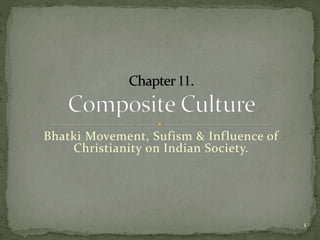The document discusses the cultural developments in India that resulted from the establishment of the Delhi Sultanate in the 13th century, including the emergence of an Indo-Islamic culture through the interaction of Turks and Indians. It then highlights several influential religious texts and sites, including the Bijak verses of Kabir, Guru Granth Sahib of Sikhism, Ajmer Sharif Dargah shrine in Rajasthan, and St. Francis Assisi Church in Kochi. The document also discusses the Bhakti movement, Sufism, and their influence in promoting religious tolerance and unity in Indian society.

















